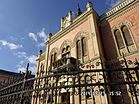Novi Sad
|
Novi Sad Град Нови Сад Hungarian: Újvidék Slovak: Nový Sad |
||||||||
|---|---|---|---|---|---|---|---|---|
| City and municipality | ||||||||
| City of Novi Sad | ||||||||
|
||||||||
|
||||||||
 Location of Novi Sad in Serbia and Europe |
||||||||
| Coordinates: 45°15′N 19°51′E / 45.250°N 19.850°ECoordinates: 45°15′N 19°51′E / 45.250°N 19.850°E | ||||||||
| Country |
|
|||||||
| Province | Vojvodina | |||||||
| District | South Bačka | |||||||
| Municipalities | 2 | |||||||
| Settled by Scordisci | 4th century B.C. | |||||||
| Founded | 1694 | |||||||
| City status | 1 February 1748 | |||||||
| Government | ||||||||
| • Mayor | Miloš Vučević (SNS) | |||||||
| Area | ||||||||
| • City proper | 106.2 km2 (41.0 sq mi) | |||||||
| Area rank | 38th | |||||||
| • Urban area | 129.7 km2 (50.1 sq mi) | |||||||
| • Admin. area | 702.7 km2 (271.3 sq mi) | |||||||
| Elevation | 80 m (262 ft) | |||||||
| Population (2011) | ||||||||
| • City proper |
|
|||||||
| • Rank | 2nd | |||||||
| • Density | 2,182.6/km2 (5,653/sq mi) | |||||||
| • Urban area |
|
|||||||
| • Admin. area |
|
|||||||
| Time zone | CET (UTC+1) | |||||||
| • Summer (DST) | CEST (UTC+2) | |||||||
| Postal code | 21000 | |||||||
| Area code(s) | +381(0)21 | |||||||
| Car plates | NS | |||||||
| Website | www.novisad.rs | |||||||
Novi Sad (Serbian Cyrillic: Нови Сад, pronounced [nôʋiː sâːd]; Hungarian: Újvidék; Slovak: Nový Sad; see below for other names) is the second largest city of Serbia, the capital of the autonomous province of Vojvodina and the administrative center of the South Bačka District. It is located in the southern part of the Pannonian Plain, on the border of the Bačka and Srem geographical regions, on the banks of the Danube river, facing the northern slopes of Fruška Gora mountain.
According to the 2011 census[update], the city has a population of 250,439, while the urban area of Novi Sad (with the adjacent urban settlements of Petrovaradin and Sremska Kamenica) has 277,522 inhabitants. The population of the administrative area of the city stands at 341,625 people.
Novi Sad was founded in 1694, when Serb merchants formed a colony across the Danube from the Petrovaradin fortress, a Habsburg strategic military post. In the 18th and 19th centuries, it became an important trading and manufacturing centre, as well as a centre of Serbian culture of that period, earning the nickname of the Serbian Athens. The city was heavily devastated in the 1848 Revolution, but it was subsequently restored. Today, along with the capital city of Belgrade, Novi Sad is the industrial and financial center of the Serbian economy; also, it was named one of the 2021 European Capital of Culture cities.
...
Wikipedia








